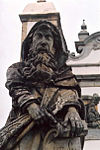Bom Jesus de Matosinhos (Congonhas)
| Bom Jesus de Matosinhos | |
|---|---|
|
UNESCO world heritage |
|

|
|
| The baroque pilgrimage church with chapels |
|
| National territory: |
|
| Type: | Culture |
| Criteria : | i, iv |
| Surface: | 2.19 ha |
| Buffer zone: | 8.77 hectares |
| Reference No .: | 334 |
| UNESCO region : | Latin America and the Caribbean |
| History of enrollment | |
| Enrollment: | 1985 (session 9) |
The Santuário do Bom Jesus de Matosinhos (" Sanctuary of the Good Lord Jesus of Matosinhos ") is a well-known Brazilian pilgrimage site at the top of the small town of Congonhas in the state of Minas Gerais , 85 km south of Belo Horizonte .
Name and story
The name of the sanctuary refers to the north Portuguese pilgrimage church Bom Jesus in Matosinhos near Porto, where a miraculous Jesus figure is venerated, known as Bom Jesus de Matosinhos , also known as "Good Jesus of Matosinhos" (or as Senhor de Matosinhos = "Lord." from Matosinhos "). Therefore Santuário do Bom Jesus de Matozinhos . The term "good Jesus" is not to be confused with Jesus as " good shepherd ", instead the figure of Bom Jesus de Matosinhos is a depiction from the Passion: Jesus as the Man of Sorrows , also known as Ecce homo .
Other terms are also used in Portuguese for the sanctuary near Conconhas: Santuário de Bom Jesus do Bacalhau , Santuário do Bacalhau , or Capela do Senhor Bom Jesus de Matozinhos .
The sanctuary was built between 1758 and 1772 on Maranhão Hill, above the town of Congonhas. The entire building complex includes the church with a large flight of stairs , a hilly forecourt and seven Stations of the Cross chapels. Architectural models were the already mentioned and eponymous church Bom Jesus de Matosinhos near Porto and the famous Portuguese pilgrimage site Bom Jesus do Monte near Braga .
In 1957 the church was elevated to a minor basilica . Since 1985 the pilgrimage site with its chapels of the Cross and sculptures by the Brazilian builder and sculptor Aleijadinho has been on the UNESCO list of world cultural heritage .
Pilgrimage church
According to the design of the architect Francisco Lima Cerqueira , the builders Domingos Antonio Dantas and Antonio Rodrigues Falcado completed the church by 1772. The facade of the church is stylistically the Brazilian Baroque , its interior is indebted to the Rococo . The baroque painter Manuel da Costa Ataíde created several paintings for the church interior .
Staircase with prophets
Twelve life-size statues of the prophets made of soapstone line the large staircase leading to the church. From the edge of the terrace you can see far into the country. Aleijadinho (Antônio Francisco Lisboa) created the late baroque prophet sculptures with his students between 1800 and 1805. The figures are holding scrolls in their hands with brisk movement, proclaiming six good and six bad messages.
Chapels with passion scenes
Below the church there are seven chapels in a garden with scenes from the passion story of Christ. The figures, carved in cedar wood and framed in color, were created by the sculptor Aleijadinho 1796–1800 with his students.
The scenes show the Last Supper , prayer on the Mount of Olives , Christ in dungeon , flagellation and crowning of thorns , Christ carrying the cross and crucifixion . The mimic expression of the characters is intentionally caricatured, because the torturers and torturers of Jesus are depicted as small, with crooked or long noses and simple faces.
gallery
literature
- Carrazoni, Maria Elisa (coordination): Guia dos bens tombados, 2nd edition, Rio de Janeiro: Expressão e Cultura 1987. ISBN 8520800920
- Barbero, Amilcare (editing): Atlas of Holy Mountains, Calvaries and devotional Complexes in Europe Novara: De Agostini 2001
- UNESCO. Patrimônio mundial no Brasil . 2nd ed. Brasília: UNESCO, Caixa Econômica Federal 2002. ISBN 8587853775
Web links
Individual evidence
- ↑ Information on the basilica , on gcatholic.org
Coordinates: 20 ° 30 ′ S , 43 ° 52 ′ W





